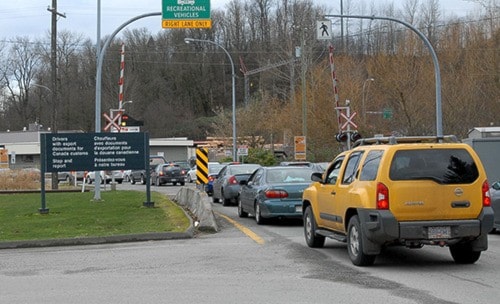by Jeff Nagel and Kevin Mills
Border crossings that are often jammed with shoppers heading south may soon get even more congested as the U.S. government is forced to lay off thousands of border employees.
The U.S. Department of Homeland Security has begun cutting employee hours and is slated to furlough 5,000 more staff by early April after Congress and President Barack Obama failed to reach a comprehensive deal by March 1 to reduce federal spending, triggering automatic spending cuts.
The initial cuts at Customs and Border Protection (CBP) are already resulting in reports of longer processing lines at some U.S. airports.
CBP officials predict waits up to 50 per cent longer at major airports – four hours or longer at peak times – and a doubling of peak waits to five hours or more at the busiest land crossings.
“Travellers should adjust their trip itineraries to account for unexpected delays,” the department warned in a statement.
The longest southbound lines at Lower Mainland crossings are weekend mornings and they could get much longer because the use of overtime is now banned.
“They hold shifts over longer or call shifts in earlier to keep as many lines open as possible – that won’t be happening,” said Ken Oplinger, president of the Bellingham/Whatcom Chamber of Commerce.
“We’re thinking it could add an extra 15 to 30 minutes onto the regular lines.”
Nexus card holders should continue to get speedy clearance but new applicants face longer approval times due to an expected surge in demand. It’s hoped the arbitrary across-the-board cuts will be unpalatable to both Republicans and Democrats, spurring them to reach a deal before border slowdowns cause serious economic damage.
“If this goes on into the summer that’s when we’re really going to have an issue,” Oplinger said. “On a summer weekend we can get two- to three-hour lineups and we could be adding 45 minutes to an hour on top of that at those peak times.”
One factor that might slow cross-border shopping is the recent slide of the loonie. The dollar is down to around 97 cents U.S. and Oplinger said a further drop to below 95 cents may begin to reduce the number of southbound shoppers from Canada.
 Despite the anticipated border waits, Abbotsford Chamber of Commerce executive director Allan Asaph (at left) doesn’t think it will discourage cross-border shoppers.
Despite the anticipated border waits, Abbotsford Chamber of Commerce executive director Allan Asaph (at left) doesn’t think it will discourage cross-border shoppers.
“Quite honestly, no. I don’t think it will have any effect.”
According to Asaph, border staffing cutbacks will only be felt during peak periods like weekends.
“Cross-border shopping is a huge issue for us,” he said. “We’re not saying to shop exclusively locally, but recognize the value of the dollars that you do spend locally.”
Asaph also said the border lines don’t tell the whole story. “When we see the border lineups, that’s the physical shopping that takes place. There’s a huge amount of shopping on the Internet that we never see.”
Truckers are also being warned they face significant delays at the borders in the weeks ahead if the U.S. budget impasse continues.
B.C. Trucking Association vice-president Trace Acres said major impacts aren’t expected for the first 30 days, as affected U.S. border staff are getting one month notice.
